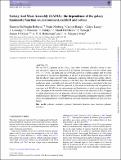Files in this item
Galaxy And Mass Assembly (GAMA) : the dependence of the galaxy luminosity function on environment, redshift and colour
Item metadata
| dc.contributor.author | McNaught-Roberts, Tamsyn | |
| dc.contributor.author | Norberg, Peder | |
| dc.contributor.author | Baugh, Carlton | |
| dc.contributor.author | Lacey, Cedric | |
| dc.contributor.author | Loveday, J. | |
| dc.contributor.author | Peacock, J. | |
| dc.contributor.author | Baldry, I. | |
| dc.contributor.author | Bland-Hawthorn, J. | |
| dc.contributor.author | Brough, S. | |
| dc.contributor.author | Driver, Simon P. | |
| dc.contributor.author | Robotham, A. S. G. | |
| dc.contributor.author | Vazquez-Mata, J. A. | |
| dc.date.accessioned | 2015-01-19T15:31:09Z | |
| dc.date.available | 2015-01-19T15:31:09Z | |
| dc.date.issued | 2014-12-01 | |
| dc.identifier | 162211361 | |
| dc.identifier | ab206fed-e5e6-486c-ad6e-df53c9848222 | |
| dc.identifier | 000346959400085 | |
| dc.identifier | 84987937779 | |
| dc.identifier | 000346959400085 | |
| dc.identifier.citation | McNaught-Roberts , T , Norberg , P , Baugh , C , Lacey , C , Loveday , J , Peacock , J , Baldry , I , Bland-Hawthorn , J , Brough , S , Driver , S P , Robotham , A S G & Vazquez-Mata , J A 2014 , ' Galaxy And Mass Assembly (GAMA) : the dependence of the galaxy luminosity function on environment, redshift and colour ' , Monthly Notices of the Royal Astronomical Society , vol. 445 , no. 2 , pp. 2125-2145 . https://doi.org/10.1093/mnras/stu1886 | en |
| dc.identifier.issn | 0035-8711 | |
| dc.identifier.uri | https://hdl.handle.net/10023/6022 | |
| dc.description | TMR acknowledges support from a European Research Council Starting Grant (DEGAS-259586). PN acknowledges the support of the Royal Society through the award of a University Research Fellowship and the European Research Council, through receipt of a Starting Grant (DEGAS-259586). This work was supported by the Science and Technology Facilities Council [ST/L00075/1]. | en |
| dc.description.abstract | We use 80 922 galaxies in the Galaxy And Mass Assembly (GAMA) survey to measure the galaxy luminosity function (LF) in different environments over the redshift range 0.04 <z <0.26. The depth and size of GAMA allows us to define samples split by colour and redshift to measure the dependence of the LF on environment, redshift and colour. We find that the LF varies smoothly with overdensity, consistent with previous results, with little environmental dependent evolution over the last 3 Gyr. The modified GALFORM model predictions agree remarkably well with our LFs split by environment, particularly in the most overdense environments. The LFs predicted by the model for both blue and red galaxies are consistent with GAMA for the environments and luminosities at which such galaxies dominate. Discrepancies between the model and the data seen in the faint end of the LF suggest too many faint red galaxies are predicted, which is likely to be due to the over-quenching of satellite galaxies. The excess of bright blue galaxies predicted in underdense regions could be due to the implementation of AGN feedback not being sufficiently effective in the lower mass haloes. | |
| dc.format.extent | 21 | |
| dc.format.extent | 8105072 | |
| dc.language.iso | eng | |
| dc.relation.ispartof | Monthly Notices of the Royal Astronomical Society | en |
| dc.subject | Galaxies: evolution | en |
| dc.subject | Galaxies: luminosity function, mass function | en |
| dc.subject | Galaxies: structure | en |
| dc.subject | Digital-sky-survey | en |
| dc.subject | Cluster galaxies | en |
| dc.subject | Special type | en |
| dc.subject | Evolution | en |
| dc.subject | Density | en |
| dc.subject | Catalog | en |
| dc.subject | Field | en |
| dc.subject | Bimodality | en |
| dc.subject | Morphology | en |
| dc.subject | Universe | en |
| dc.subject | QB Astronomy | en |
| dc.subject | QC Physics | en |
| dc.subject.lcc | QB | en |
| dc.subject.lcc | QC | en |
| dc.title | Galaxy And Mass Assembly (GAMA) : the dependence of the galaxy luminosity function on environment, redshift and colour | en |
| dc.type | Journal article | en |
| dc.contributor.institution | University of St Andrews. School of Physics and Astronomy | en |
| dc.identifier.doi | 10.1093/mnras/stu1886 | |
| dc.description.status | Peer reviewed | en |
This item appears in the following Collection(s)
Items in the St Andrews Research Repository are protected by copyright, with all rights reserved, unless otherwise indicated.

